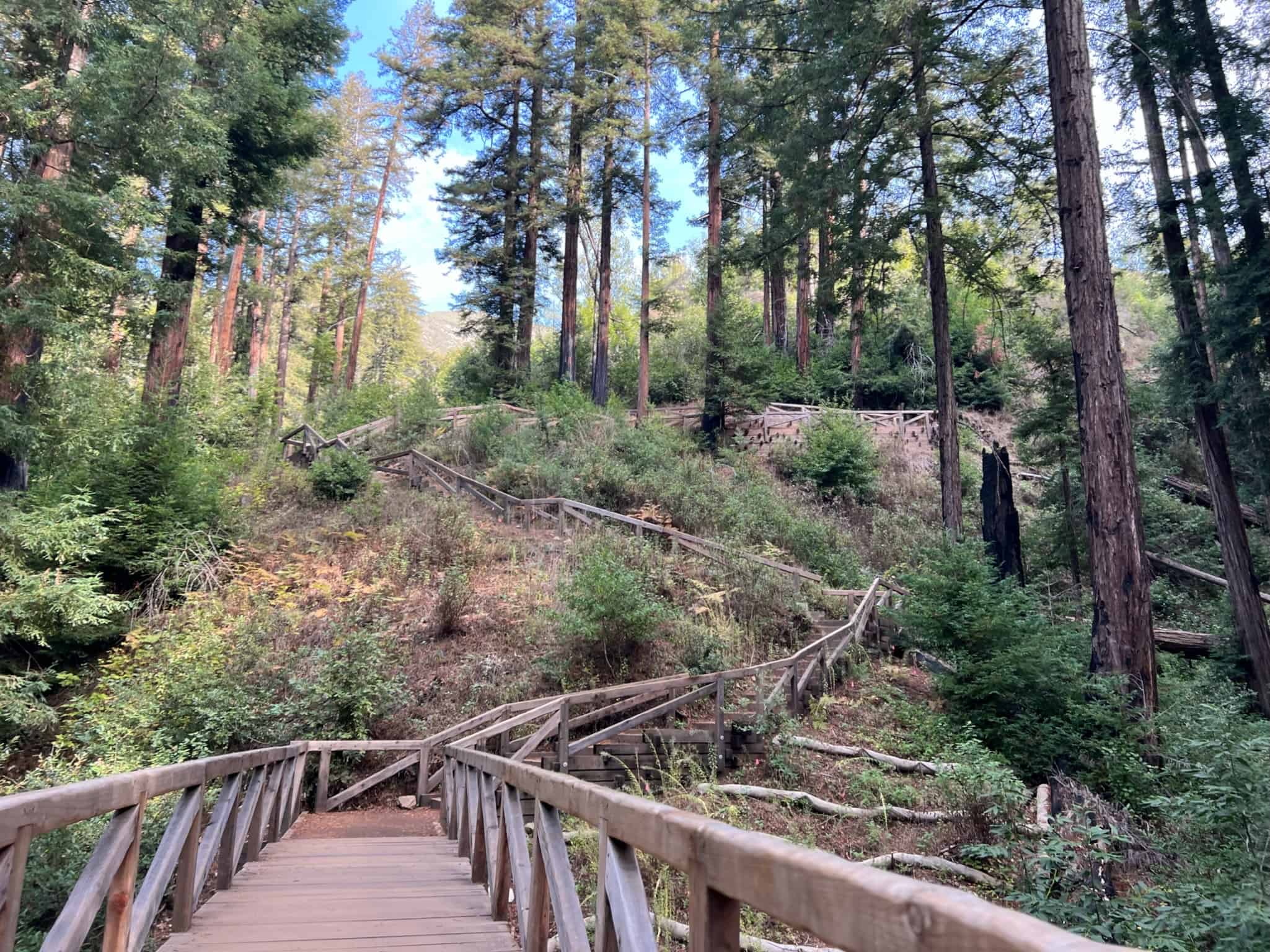31 Best Bay Area Car Camping Destinations
While the Bay Area may be most commonly associated with places like San Francisco, The Golden Gate Bridge, and Silicon Valley, it is also home to an abundance of great camping opportunities. That’s why I put together this list of the 31 Best Bay Area Car Camping Destinations.
I broke the list down into four regions for ease of navigation. I focused on campgrounds within roughly a 2-2.5 hour drive from the Bay Area (depending on your exact starting point). As you will see there are a few in Big Sur that have a longer driving time, but it is such a phenomenal place, I just couldn’t leave it out!
From beach camping to ancient redwoods, to rolling hills covered in oak trees, and dramatic mountain peaks there are a lot of phenomenal car camping opportunities within a short distance of the Bay Area!
Best Bay Area Car Camping:
North Of San Francisco
For the North Of San Francisco section I choose to focus primarily on the Marin Headland and Mt Tamalpais area. We love to explore this area because you can go from dense redwood forests to the beach in just a day hike!
In particular, we are huge fans of Muir Woods National Monument. While Muir Woods doesn’t have a campground of its own, you will see that there are a number of campgrounds nearby.
I added one campground in the Napa area, but know as you continue further North there are many additional phenomenal places to camp, both along the coast and inland, we’ll save those for another day!
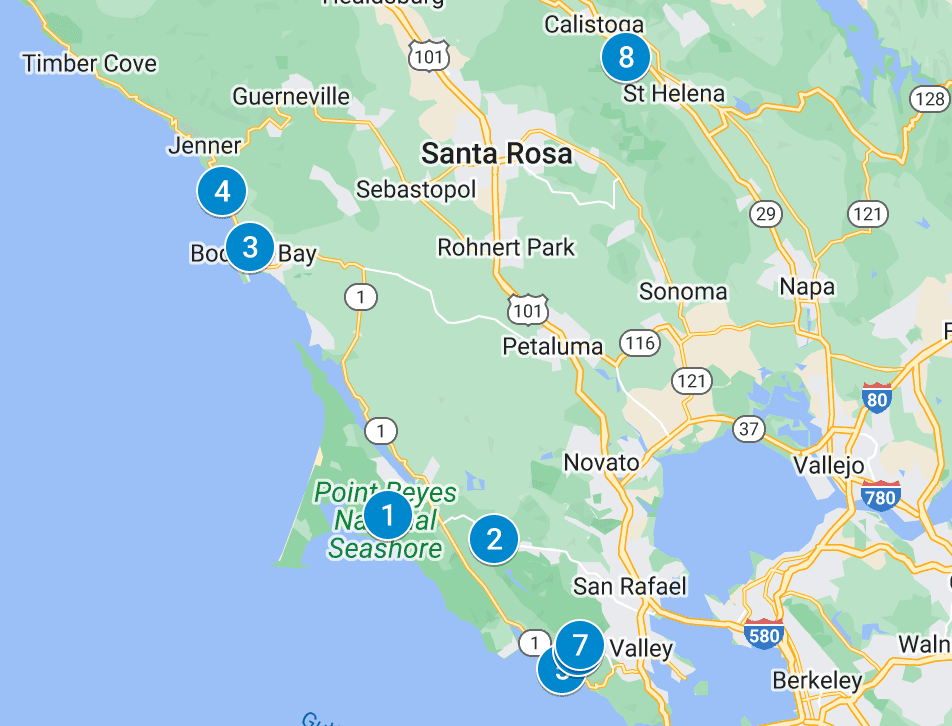
- Point Reyes National Seashore
- Samuel P. Taylor State Park
- Bodega Dunes Campground
- Wrights Beach Campground
- Steep Ravine Cabins and Campground
- Pantoll Campground, Mt Tamalpais
- Bootjack Campground, Mt Tamalpais
1. Point Reyes National Sea Shore
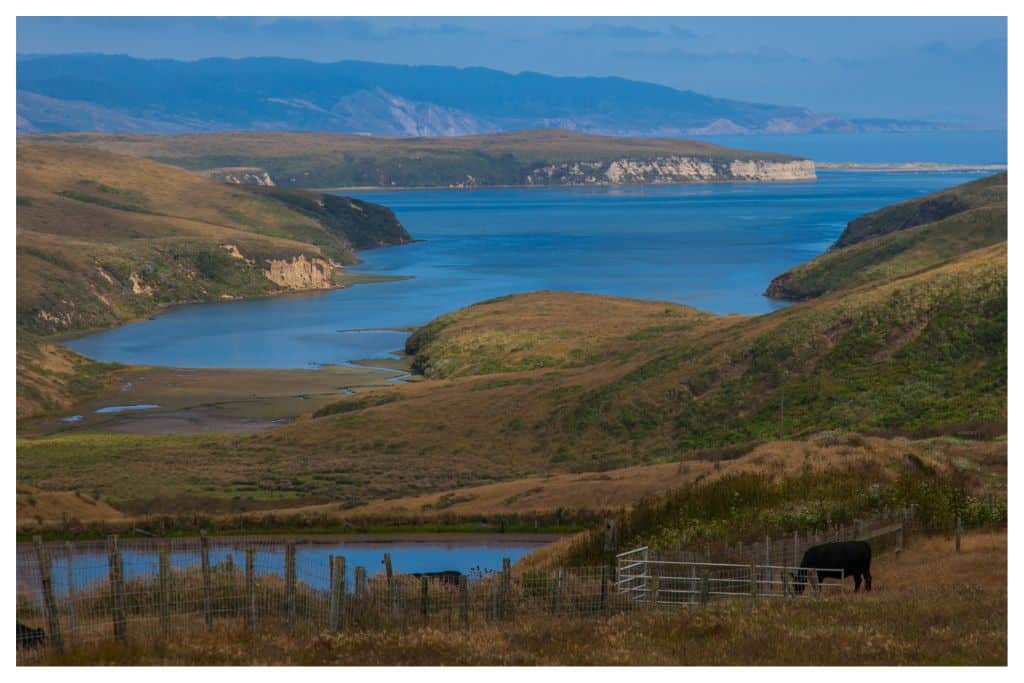
Point Reyes National Seashore is brimming with natural beauty and is a phenomenal example of the California coastal habitat in its natural state. The park encompasses 100 square miles and features 80 miles of undeveloped coastline.
Within the park are a diverse variety of natural habitats. Beaches, estuaries, coastal grasslands, and dense forests can all be found. The diversity of habitat provides homes for an even more diverse array of wildlife.
Perhaps most notable are the elephant seals which are prominent on the park beaches from December to May. Whale watching is also a highlight with the best times being in January and again in late March.
Point Reyes National Seashore also has a rich human history. The Coast Miwok inhabited this area prior to the arrival of Europeans. Kule Loklo is a recreated Miwok village within the park. While no village ever existed in this specific spot it serves as a realistic representation of what living conditions would have been like for the Coast Miwok.
Camping opportunities within the park itself are limited to hike, bike, and boat-in sites. However, there are numerous campgrounds in the nearby area that are great staging points for exploring Point Reyes National Seashore.
Olema Campground is a private campground located just outside the park that offers both RV and tent camping. Full hook-up sites are available for RVs and trailers. Shared bathrooms with hot showers are available for tent campers. All sites include a picnic table and a fire ring.
2. Samuel P. Taylor State Park
Just five miles down the road from Point Reyes National Seashore is Samuel P Taylor State Park. This almost 3,000-acre park is a great area to explore on its own and is also a great spot to camp if you are wanting to visit the nearby Point Reyes National Seashore.
Samuel P Taylor State Park features a variety of landscapes including lush redwood forests, rolling hills dotted with oak trees, and Barnabe Peak, one of the best viewpoints in Marin.
You can hike through all three terrains, including up to the top of Barnabe Peak. There is a smooth (partly paved) and relatively flat bike path that parallels Lagunitas Creek.
The campground is primarily located in the Redwood forest section of the park. While some sites can accommodate small trailers or RVs no hookups are available. Sites do include picnic tables and fire rings. Drinking water and hot showers are also available. While the campground is typically open year-round, some sections often close in the winter due to seasonal flooding.
3. Bodega Dunes
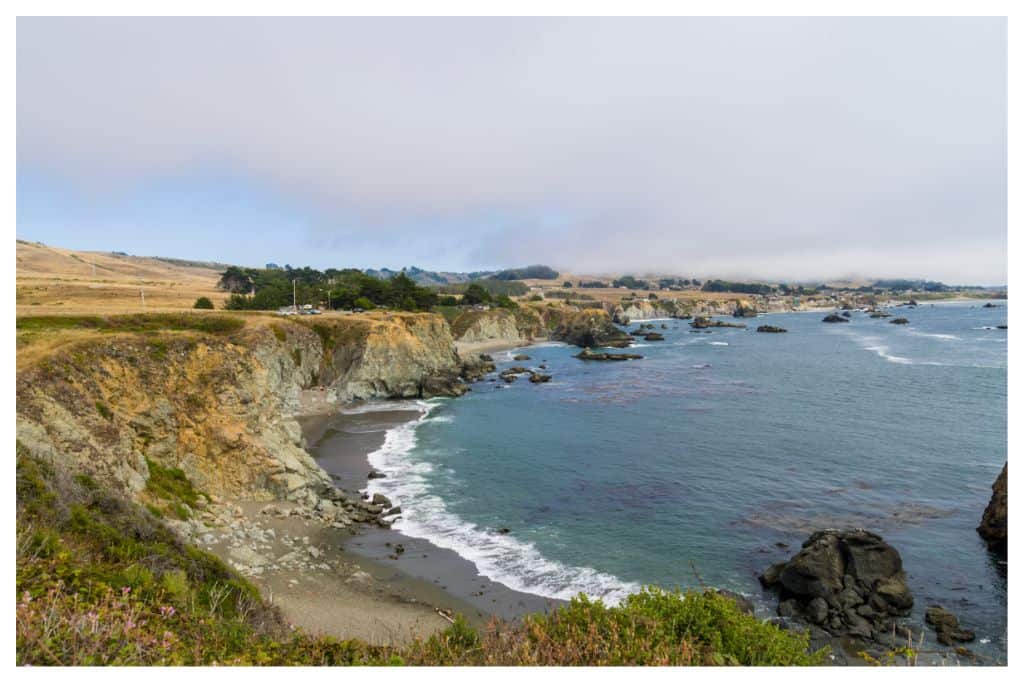
Located an hour and a half north of San Francisco, Bodega Dunes Campground lies within the Sonoma Coast State Park. The park covers 17 miles of coastline and encompasses numerous beaches separated by rock bluffs and headlands.
There are numerous access points to the park from parking areas along highway 1. There are a few hiking trails throughout the park but the main attraction is the beaches. The park is rich with wildlife and in particular, is great for birding, with over 300 species of birds, and whale watching from December through April during the Gray Whale migration.
The campground features 99 campsites when fully open. Individual sites include picnic tables and fire rings. Shared bathrooms have flush toilets and token-operated hot showers. There is also a fill station for potable water. Trailers can be accommodated up to 31 feet, but there are no hookups available and the dump station is currently closed with no timeline to reopen.
4. Wrights Beach
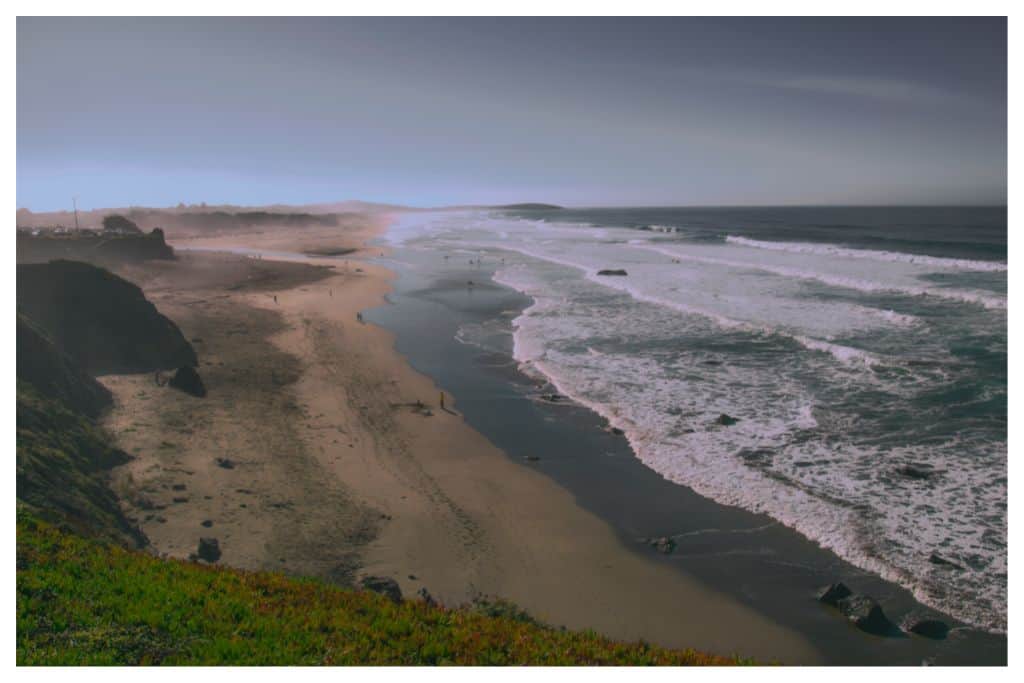
Wrights Beach Campground is also located within Sonoma Coast State Park just five miles north of Bodega Dunes. Wrights Beach is a smaller campground with just 27 sites available.
Wrights Beach Campground is notable because it is one of the few places in California where you can truly camp on the beach. A number of the sites open up directly onto the beach and all most all of the sites include ocean views.
Individual sites include picnic tables and fire rings. The shared bathrooms have flush toilets and running water. However, no showers are available and the water is not considered potable so do not cook or drink with it. Both the showers and potable water filling station at Bodega Dunes Campground, located five miles to the south, are available for use by campers at Wrights Beach Campground.
5. Steep Ravine Cabin and Campground

Perched on a hillside overlooking the Pacific Ocean and located within Mt Tamalpais State Park lays a true California Gem, Steep Ravine Cabins and Campground. This secluded location has 9 cabins and 6 campsites, all of which provide a magnificent view of the Marin coastline and the Pacific Ocean.
The cabins were originally built in the 1940s and were privately owned until the 60s. They were converted to State Park cabins in the early 80s. Each cabin has an indoor picnic table, two bedrooms with sleeping platforms, and a wood-burning stove.
While there is a shared bathroom the cabins themselves do not have a bathroom or running water. The sleeping platforms do not have a mattress or any bedding so you will need to provide your own. What makes these cabins so special is the view, they have numerous large windows providing gorgeous views.
Additionally, there are 6 primitive campsites available at Steep Ravine. The campsites have picnic tables and a fire ring. A shared bathroom is available, but no showers.
Both the cabins and campground are extremely popular so be sure to make your reservation 6 months in advance as soon as they become available.
6. Pantoll Campground, Mt Tamalpais
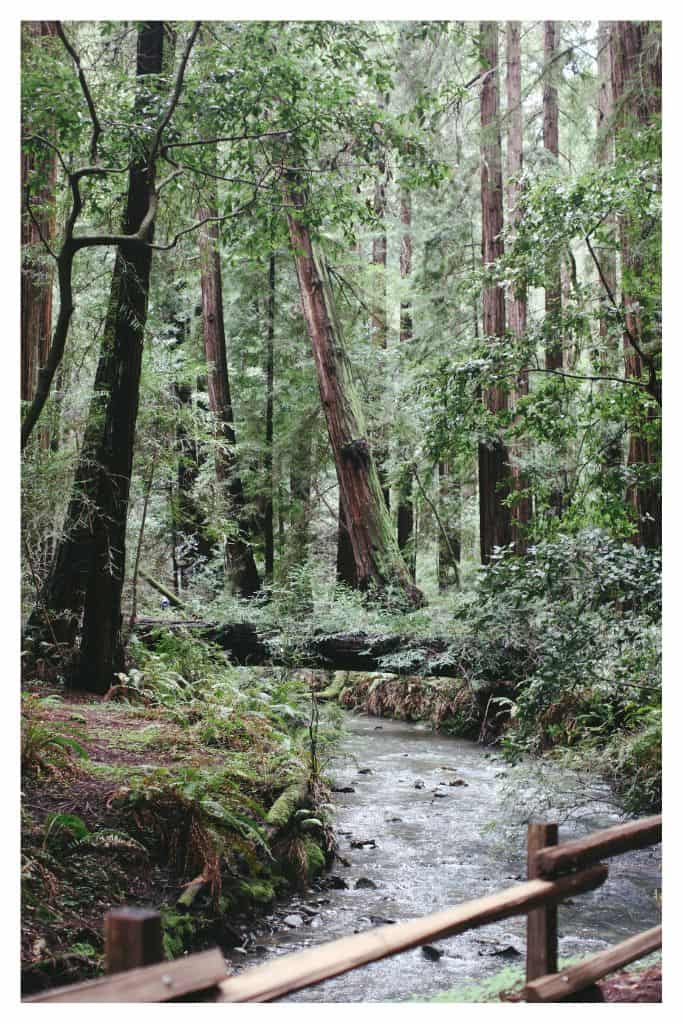
Pantoll Campground is one of two first-come-first-served campgrounds in Mt Tam State Park, the other being Bootjack Campground. Pantoll is located just off the Panoramic Highway along the forested slopes of Mt Tam.
Sites here are tent-only and are all a short walk from a central parking area. There are 17 sites available which include picnic tables, fire rings, and stone-built campfire grills. Drinking water is available, as well as shared bathrooms.
Many of Mt Tam’s best trails can be accessed from the campground, including hiking to the summit. Additionally, Muir Woods National Monument is just a short distance away. It is possible to hike directly from the campsite down into Muir Woods.
As these sites are all first-come-first-served you’ll want to arrive early to secure a spot.
7. Bootjack Campground, Mt Tamalpais
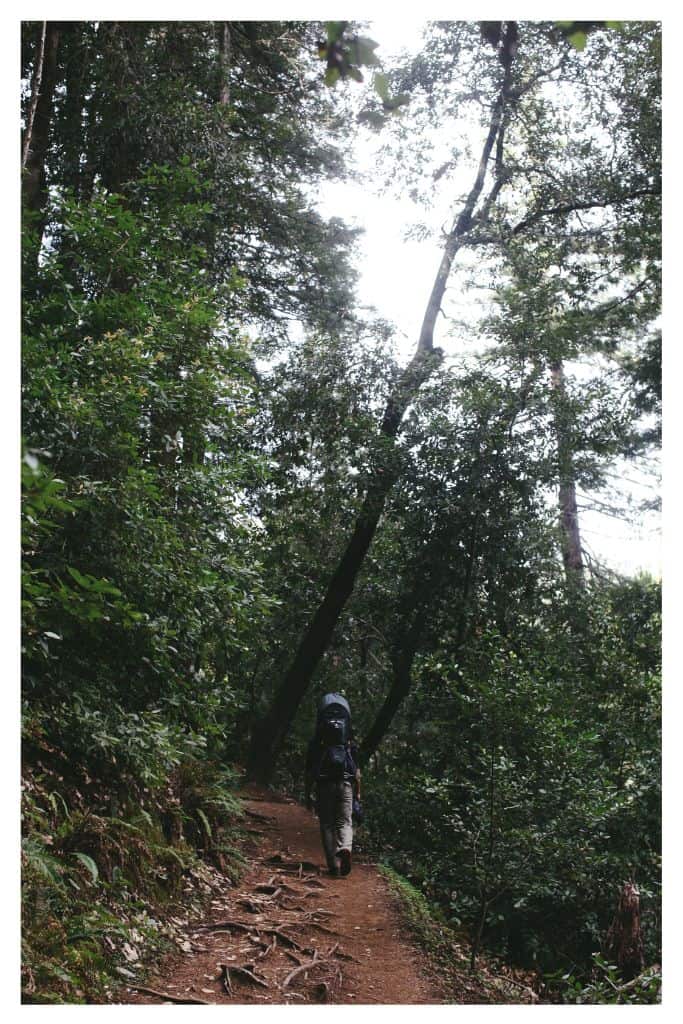
Bootjack Campground is just up the road from Pantoll and is also located within Mt Tam State Park. It is also a first-come-first-served campground with tent-only walk-in sites.
There are 11 sites available here and each includes a picnic table and campfire rings. Bathrooms provide running water and flush toilets but no showers.
Camping at Bootjack is all about access to the phenomenal hiking the area has to offer. From the campground, you can hop on a trail down into Muir Woods National Monument, or head up to the peak of Mt Tam for views of the whole area.
8. Bothe Napa Valley
Bothe-Napa Valley State Park is located in the heart of California’s wine country. Just 5 miles north of St Helena the park provides one of the few camping opportunities in the area.
This 1,900-acre park is home to a redwood forest and rolling hills more typical of the Napa Valley.
The park offers three types of accommodation; camping, cabins, and yurts. The campground offers a total of 43 sites. RVs up to 31 feet and trailers up to 24ft are allowed, but there are no hookups available. All sites include picnic tables and fire rings. Bathrooms have running water, flush toilets, and coin-operated showers.
There are 5 private cabins available, all of which include a full kitchen, refrigerator, and private bathroom. Cabins come in two layouts both of which are meant to accommodate four people.
Additionally, there are a total of 10 yurts available. The yurts include a table and chair as well as cots indoors. Linens are not provided so you will need to bring your own sleeping bag or blankets. Each yurt has an outdoor firepit and picnic table. Shared bathrooms are available nearby.
Great hiking is available throughout the park, passing through a variety of terrains. The park also has a swimming pool available to campers to cool off after a hot summer day.
Best Bay Area Car Camping:
East Bay & Pinnacles
As you move east of San Francisco Bay the most distinct change is the climate and terrain. You will move from the lush redwood forests and sandy beaches of the coast to much drier, grassy rolling hills, dotted with oak trees and shrubs. The exception is Uva’s Canyon which is a wetter more green forest than the other locations in this section.
Many of these destinations are renowned for their spring wildflower blooms, the Pinnacles, and Henry Coe in particular.
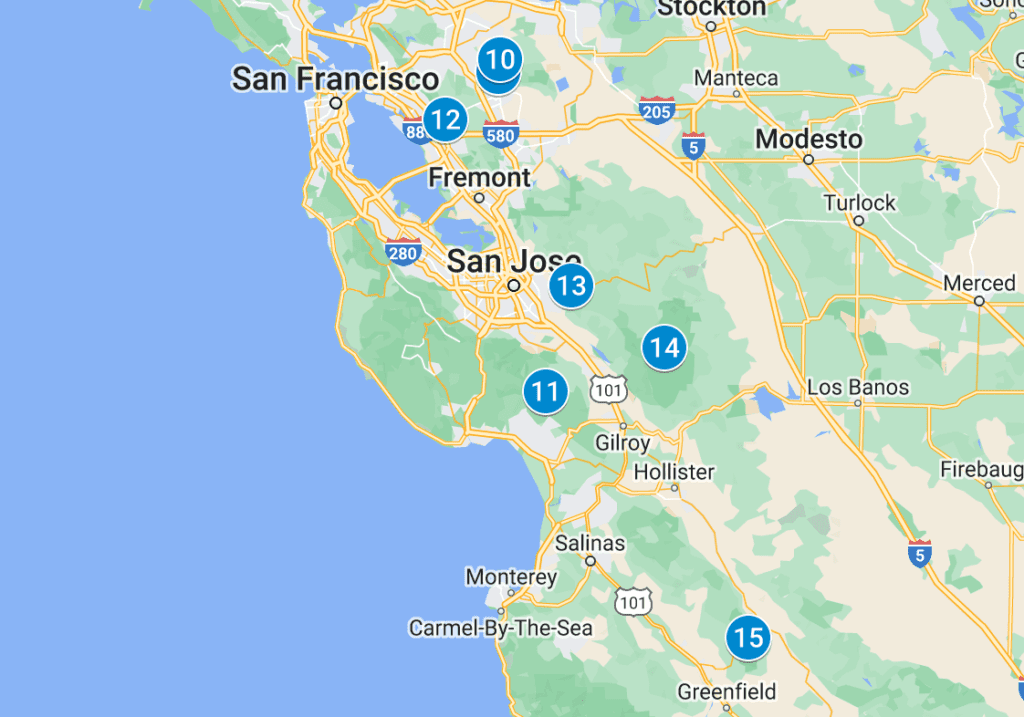
- Live Oak Campground, Mt Diablo
- Juniper Campground, Mt Diablo
- Uvas Canyon County Park
- Anthony Chabot Family Campground
- Joseph D. Grant County Park
- Henry W. Coe State Park
- Pinnacles National Park
9. Live Oak Campground, Mt Diablo
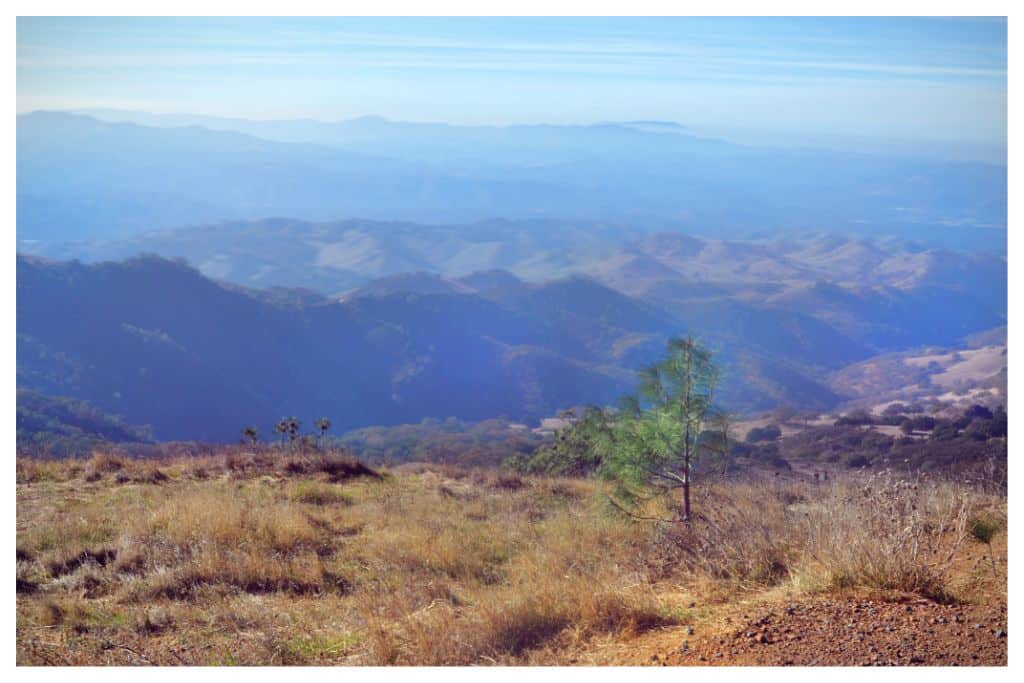
Visiting Mt Diablo is all about taking in the view from the 3,849-foot summit. As mountains go, this may not seem very tall, but it towers above almost everything else in the near vicinity providing spectacular views.
On a clear day, you can see sights such as the Farallon Islands, the Sierra Nevada, and Lassen Peak, which is 200 miles away!
Live Oak Campground, as its name suggests, is set amongst coastal live oaks about halfway up Mt Diablo. It is an old campground originally built in the 1930s. The stone Diablo Fire pits date back to its original construction.
The campground features 22 sites in total that all have picnic tables and fire rings. However, in times of drought, the use of fire rings will be prohibited.
While the bathrooms do have flush toilets and showers, be aware that in drought times these may be closed and portable toilets provided in their place.
Note that the campsites here are fairly small and close together. Sites on the outside of the loop provide slightly more space and privacy.
10. Juniper Campground, Mt Diablo
Juniper Campground is located higher up along the slopes of Mt Diablo at a height of roughly 3,000 feet. It sits perched on a plateau and provides excellent views of the San Ramon Valley.
Juniper is a larger campground with a total of 36 sites. The sites themselves are generally larger in comparison to Live Oak Campground as well.
The sites have picnic tables and fire rings. The bathroom provides flush toilets and showers. Similar to Live Oak Campground, in times of drought all fires are prohibited and water is turned off in the bathrooms. Portable toilets are provided in these instances.
The sites on the south side of the campground have a fantastic view directly from the site. If you aren’t lucky enough to snag one of these you can still catch the views with just a short walk to one of the public viewpoints.
From the campground, you can reach the summit in as short as a 3-mile hike. A longer 7-mile option wraps around the mountain before making its way to the summit.
11. Uvas Canyon County Park
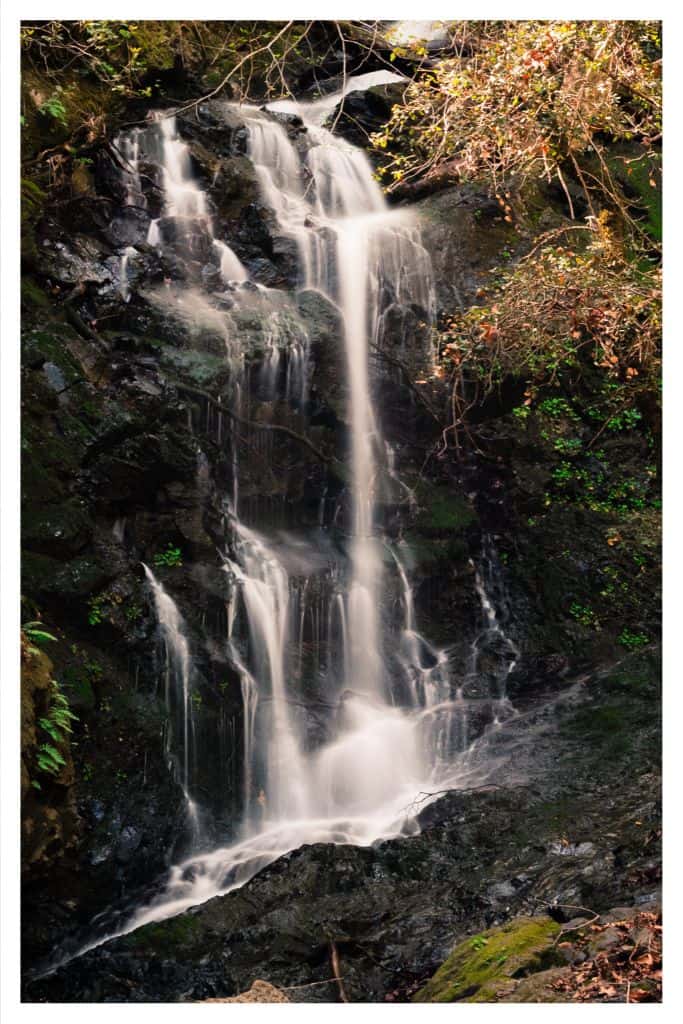
Uvas Canyon County Park is part of the Santa Clara County Park System. The park is located on the east side of the Santa Cruz Mountains in a lush forested area. The park is most known for its hiking, in particular the Waterfall Loop. This one-mile loop trail follows Swanson Creek and passes numerous falls.
The campground features 25 sites. Each includes picnic tables and fire rings. Potable water is available, as are bathrooms with flush toilets and showers. The park can accommodate small RVs and trailers. The stated limit is 20 feet for RVs and 12 feet for trailers.
12. Anthony Chabot
Anthony Chabot Family Campground is located within Anthony Chabot Regional Park, which is part of the East Bay Regional Parks District. The park is located in Castro Valley, just outside of Oakland.
The campground sits along the shores of Lake Chabot. There are hiking trails throughout the park that wind through eucalyptus, grasslands, and chaparral areas. A number of the trails can actually connect to other parks in the region. In addition to hiking, fishing is popular in Lake Chabot.
The campground itself is located on a hilltop amongst a grove of eucalyptus. There are a total of 75 sites, including 12 RV sites with full hookups, and 10 walk-in tent sites. Bathrooms have running water and hot showers available.
13. Joseph D Grant County Park
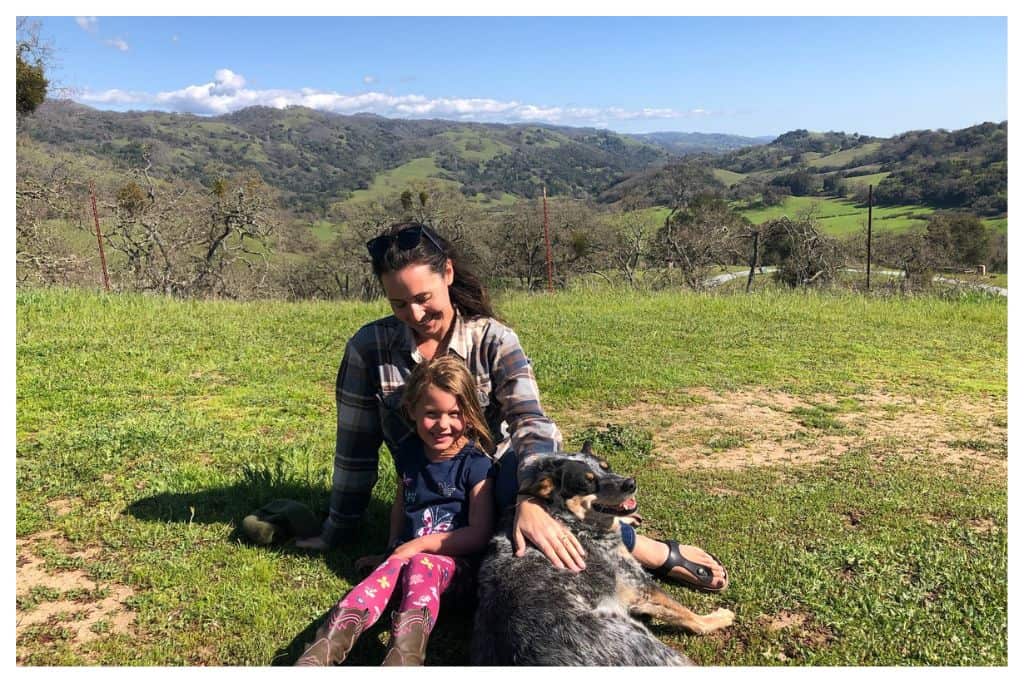
Joseph D Grant County Park is located on Mt Hamilton just east of San Jose. The park is part of the Santa Clara County Park system and is the largest park in the system at 10,882 acres.
Joseph D Grant is set amongst rolling grassy hills dotted with oak trees. The main draw is the 51-mile trail system accessible to hikers, horses, and mountain bikes. The park hosts a variety of events that utilize the trail system from organized equestrian rides to endurance races.
The land the park occupies was formerly a cattle ranch, and to this day some sections of the park are reserved for cattle grazing. The Grant Ranch House is still standing along with a variety of other buildings that were part of the ranch. The oldest of them dates back to the late 1800s.
My kids love wandering around the grounds of these historic buildings and dreaming about what it would have been like to live in this older time. There is a great rose garden that is well-maintained to this day.
The campground has a total of 22 sites. Each site is equipped with a picnic table and a fire ring. Bathrooms have running water and flush toilets but no showers. The sites are set atop a hill amongst the oak trees and thus most have good shade. All sites are open to tents, RVs, or trailers.
There are two roads into the park. Most visitors will want to take highway 130 (Mt Hamilton Road). The other option, Quimby Road, is a very narrow and windy road not suitable for trailers, RVs, or large vehicles of any kind.
14. Henry Coe State Park
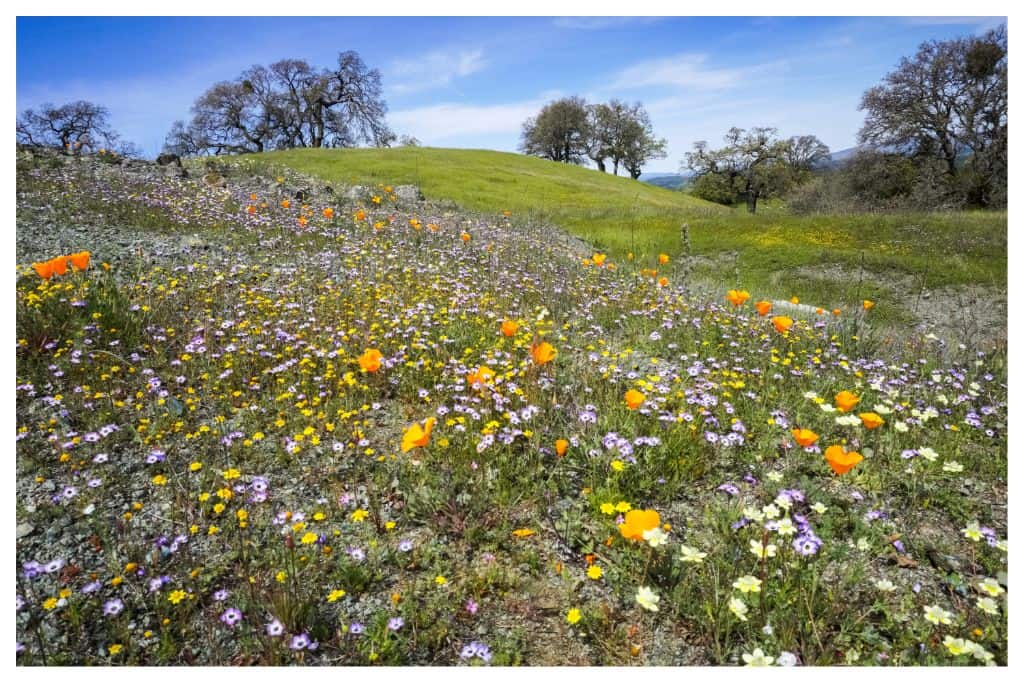
Henry Coe State Park is located in the Diablo Mt Range east of Morgan Hill. At 87,000 acres it is one of the largest state parks in the California system. The majority of the park is undeveloped, making Henry Coe a great place to escape the hustle and bustle of the nearby cities.
After rainy years Henry Coe is known for magnificent wildflower blooms. A variety of flowers, including the famous California Poppy, will begin to bloom in late February and can cover the hillsides by early April.
Spring and Fall are the best times to visit as temperatures in the summer months can regularly top 100.
The campground has a total of 20 sites, 11 of which are tent-only sites. Sites include a picnic table and a fire ring. There is potable water and pit toilets available within the campground. Flush toilets are available at the visitor center just a short walk away. No showers are available.
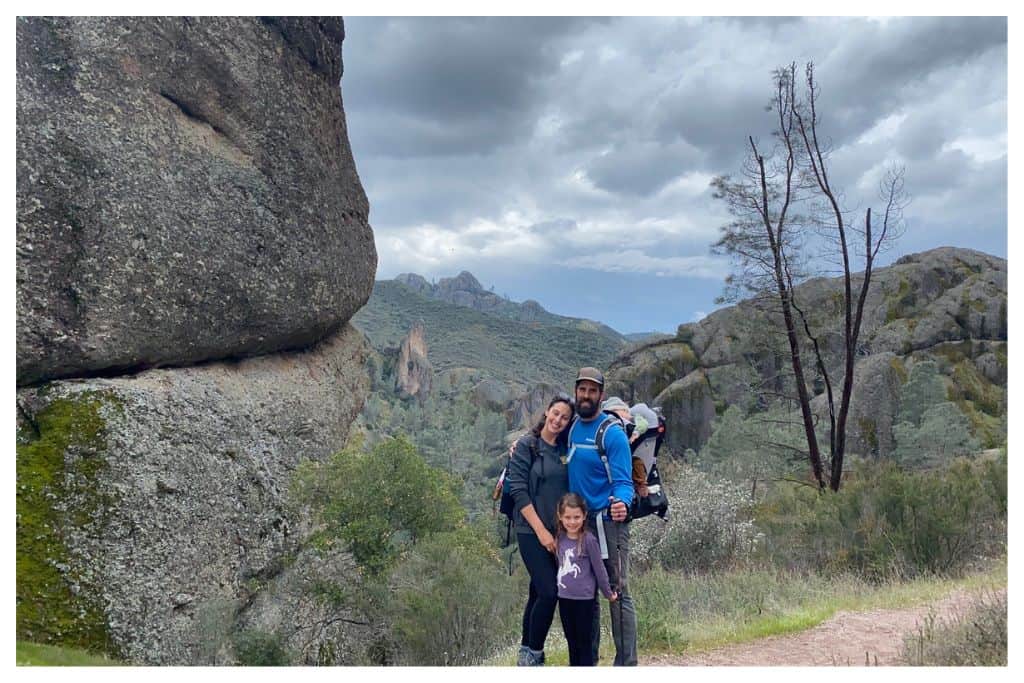
15. Pinnacles National Park
Pinnacles National Park is located east of the town of Soledad about an hour and a half south of San Jose. Pinnacles is the newest and smallest of California’s nine national parks. Pinnacles is perhaps most well known for being one of the few remaining places where California Condors can be found living in the wild.
The California Condor is one of the world’s largest flying birds and once populated much of the western united states. By the late 1900’s they were essentially extinct in the wild, due primarily to human activities. Conservation efforts reintroduced them to the wild in a few select places, including the Pinnacles.
The Pinnacles also offers a variety of great hiking, from climbing through the park’s namesake craggy peaks to exploring the two caves within the park. The Pinnacles also boasts fantastic wildflowers during the spring after wet winters.
The Pinnacles Campground is accessed via the east entrance to the park on Highway 25. The campground offers a variety of sites including one RV loop that has water and electrical hookups. The majority of the sites are open to tents or RVs. The RV loop provides the least privacy of all sites in the campground.
All sites include picnic tables and fire rings. However, fires are often prohibited for much of the year during dry conditions. Bathrooms include running water and flush toilets. There are coin-operated showers available in the bathroom near the camp office.
There is a small camp store that sells souvenirs and essential food items. There is also a pool located behind the camp office and store. The Pinnacles can often be hot so this is a great way to cool off after a long day of hiking.
One of the great things about The Pinnacles is that it isn’t nearly as crowded as many other national parks and is thus typically much easier to get campsites. While it does fill up on popular weekends, there are many other times of the year when it is still enjoyable and much quieter.
Best Bay Area Car Camping:
Half Moon Bay – Monterey Bay
Being that I was born and raised in Santa Cruz and it is where my family resides today, I may be a little bit partial toward this section of the list. Of course, if you ask me, it’s well deserved!
I included in this section the coast from San Francisco down to Santa Cruz as well as the Monterey Bay and the Santa Cruz Mountains, which serve as the backdrop for it all. From the ancient redwoods of Big Basin, which are 1,800 years old and reach heights of 329 feet, to the coastal tide pools that are home to fascinating creatures of all shapes and sizes, this small area of Central California offers limitless exploration.
I know, as I’ve spent my whole life exploring here, and still have countless spots to check off my bucket list!
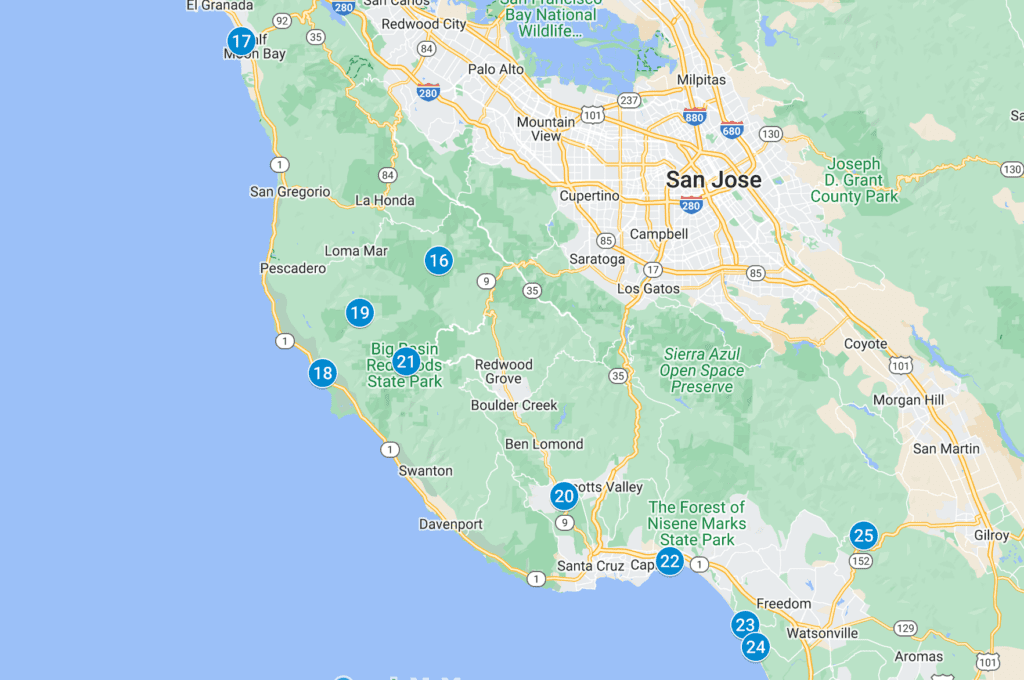
- Portola Redwoods State Park
- Half Moon Bay State Beach
- Costanoa
- Butano State Park
- Henry Cowell Redwoods State Park
- Big Basin Redwoods State Park
- New Brighton State Beach
- Manresa State Beach
- Sunset State Beach
- Mt Madonna County Park
16. Portola Redwoods
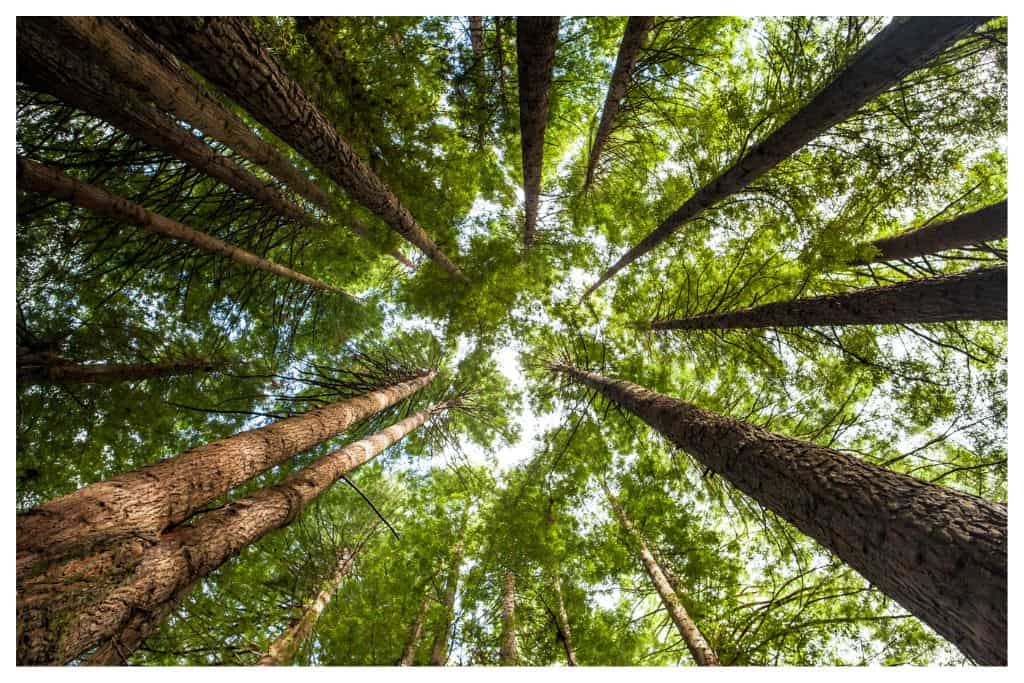
Located deep in a redwood forest, sandwiched between the coast and the South Bay Area, Portola Redwoods is a lush and beautiful getaway. Although, as the crow flies you are only a few miles from the nearest town, at Portola Redwoods you will have the feeling of complete seclusion.
This densely forested park provides 18 miles of hiking trails that meander through the redwoods, along creeks, and past waterfalls. Trails range from easy to strenuous. Families with small kids can stick close to the campground while more adventurous hikers can tackle the longer more challenging trails.
The campground includes a total of 55 sites. All sites include a picnic table and a fire ring. Trailers and RVs are welcome but sites can only accommodate a max of a 21ft trailer or 24ft RV. Bathrooms include running water, flush toilets, and coin-operated showers.
17. Half Moon Bay State Beach
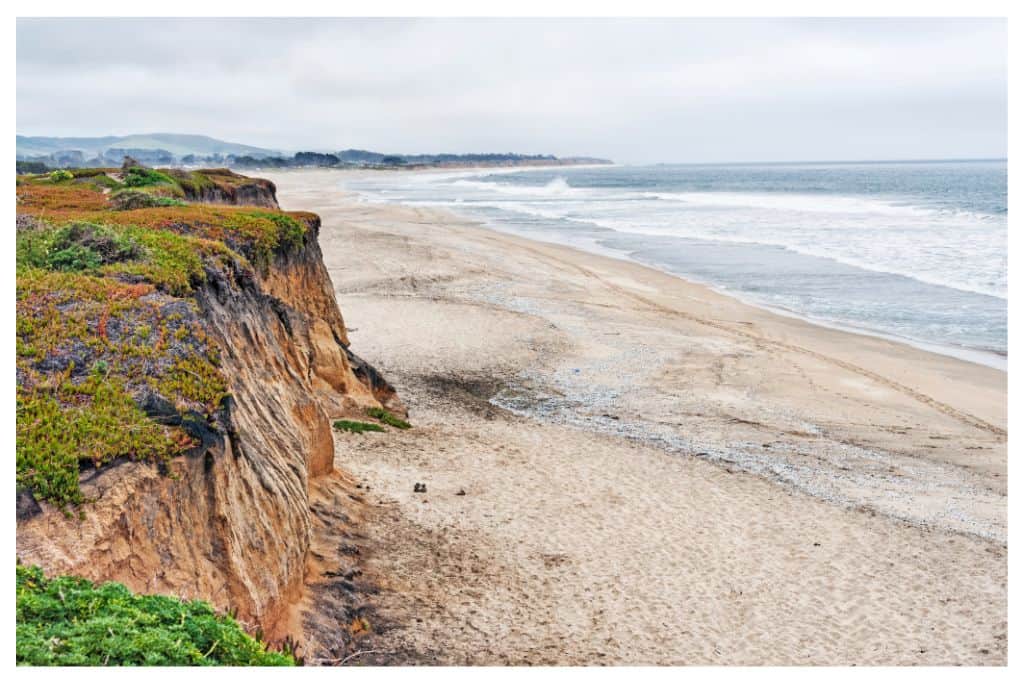
Half Moon Bay State Beach is located just south of San Francisco along California’s scenic Highway 1. The state beach includes four miles of sandy coastline in Half Moon Bay. Being one of the closest beach areas to San Francisco and the surrounding suburban area Half Moon Bay is a popular picnic destination on summer days.
The Half Moon Bay Coastal Trail is an 11.5-mile stretch of trail that runs parallel to the coastline and is mainly paved. It is accessible to hikers and bikers alike and even has some sections available for horseback riding. There are beautiful views throughout the trail and it is a fantastic way to experience a variety of coastal habitats and see the local coastal wildlife.
The campground offers both tent and RV sites. Some RV sites are available with electric hookups, however, there are no water or sewer hookups available. There is a dump station and water filling station available. All sites include a picnic table and a fire ring. Bathrooms have running water and coin-operated hot showers are available.
18. Costanoa
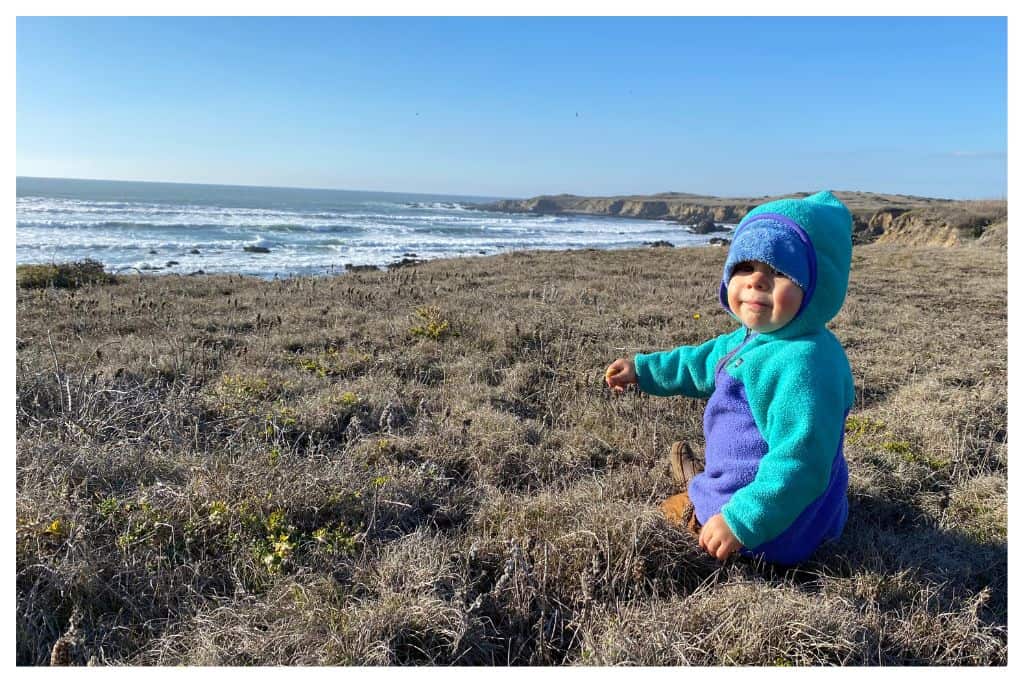
Costanoa is located on Highway 1 just north of Ano Nuevo State park roughly halfway between the towns of Santa Cruz and Half Moon Bay. Costanoa serves as a great base camp to explore this wonderful stretch of coastline.
Nearby adventures include seeing the elephant seals at Ano Nuevo State Park, visiting the historic Pigeon Point Lighthouse, exploring the tidepools at davenport landing beach, or going for a hike in the redwoods at Butano State Park.
Coastnoa itself is a private facility that offers a variety of lodging options. There is a lodge and cabins for those wanting full accommodations. Additionally, there are tent cabins that provide beds and a picnic table. Shared bathrooms offer running water, flush toilets, and hot showers. You even have access to a sauna!
Tent cabins do not have fire rings but, there are communal campfires in a few spots where a campfire is maintained by staff throughout the evening.
Tent camping is available, however, there are no individual sites. Rather they provide a shared grassy area where you can pitch a tent. There are shared water, electricity, and picnic tables available.
The bulk of Coastanoa is an RV park. There are two types of RV sites available. There are two loops that are entirely paved and are essentially parking spaces for large trailers and RVs. A third loop, however, offers more traditional campsites, that are set amongst the trees, and offer more space and privacy, as well as individual fire rings and picnic tables.
19. Butano State Park
Butano State Park is located off Highway 1 between the towns of Santa Cruz and Half Moon Bay. The park was originally established in 1957 and covers an area of 4,000 acres. Butano’s primary draw is its 40 miles of hiking trails that traverse through its lush redwood forests.
In addition to the coastal redwoods, the park is home to a variety of other ecosystems including areas of oak woodland and sunny chaparral. From the park entrance, it is just a short drive down to the coast and Gazos Creek State Beach. Head north or south from here for a variety of other great beaches and coastal sites to explore.
The Ben Reis campground in Butano State Park hosts 21 drive-in sites as well as 18 walk-in sites all nestled among the redwoods. The walk-in sites have a nearby parking area, but campers must carry all equipment a short walk down to their individual sites. Restrooms with running water are available.
The Ben Reis campground is currently closed due to fire-related damage to the park’s water system. Check with California State Parks for re-opening dates.
20. Henry Cowell Redwoods
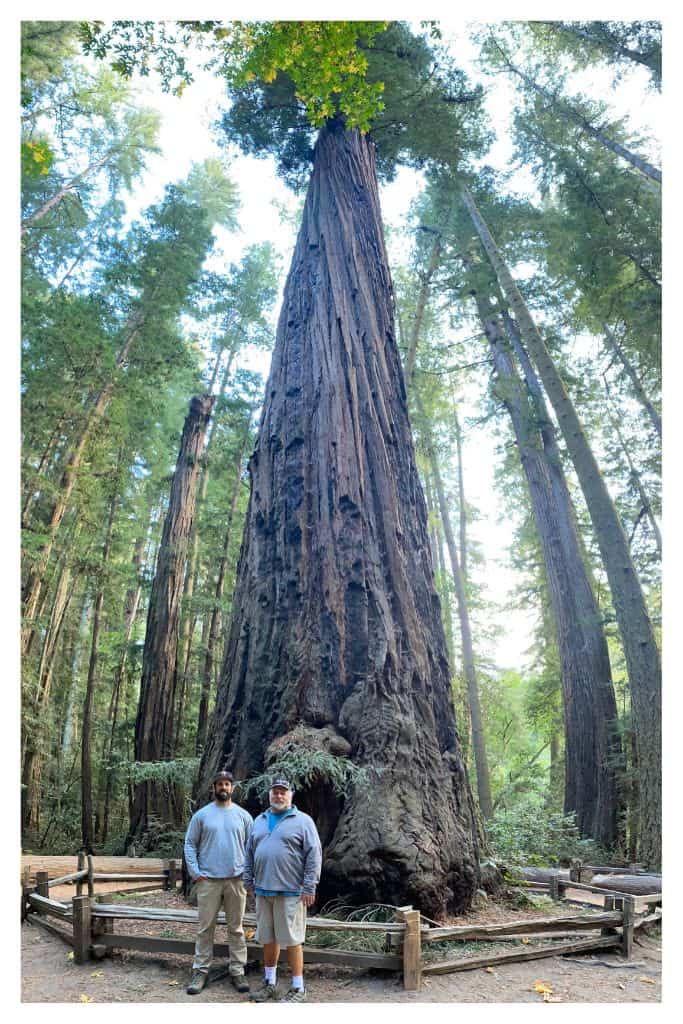
Henry Cowell Redwoods is located just outside the town of Santa Cruz near the small mountain town of Felton. The park is most famous for its 40-acre grove of old-growth redwoods. The Redwoods in this grove are as old as 1,500 years old and the tallest reaches a height of 277 feet!
Overall Henry Cowell encompasses 4,650 acres of land. In addition to the redwoods, there are three distinct habitats, grasslands, river/riparian, and sandhills.
The park’s campground offers 107 sites available to both tents and RVs. The campground is situated in a mixed pine and oak forest near the Santa Cruz Sand Hills, which are rare ancient marine deposits. Evidence of a time roughly 15 million years ago when this area lay beneath the ocean.
Sites in the campground have picnic tables and fire rings and shared bathrooms are available. Bathrooms offer coin-operated hot showers. The campground can accommodate trailers up to 31 feet and RVs up to 35 feet, however, there are no dump or water fill stations available.
The campground is connected to the old-growth redwood grove via a 2-mile hiking trail. Alternatively, the redwoods can be reached via a roughly 5min drive. During the summer months, the nearby Roaring Camp Railroad operates a train ride through the redwoods all the way down to the beach.
21. Big Basin Redwoods State Park
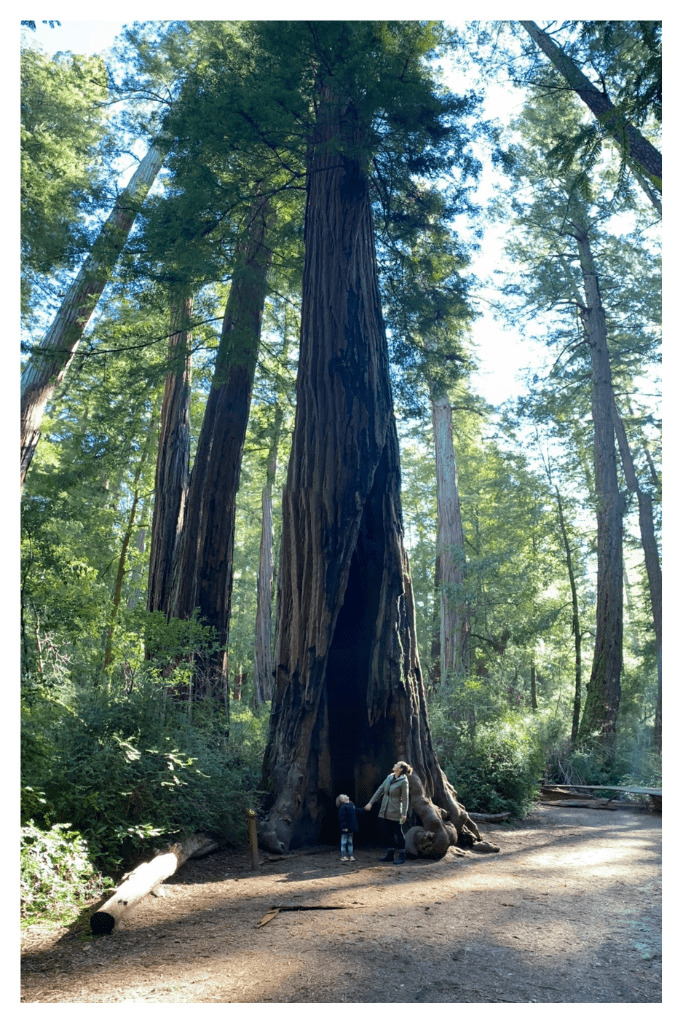
Big Basin Redwoods State Park was founded in 1902 and is California’s oldest state park. It is home to the largest grove of ancient coastal redwoods south of San Francisco. The Big Basin Redwoods reach up to 1,800 years in age and an astounding 329 feet tall!
Sadly, Big Basin was dramatically impacted by the 2020 CZU fire during which 97% of the park’s property burned. Including all of the historic buildings. Thankfully, the majority of the old-growth redwoods survived the fire and the park is well on its way to recovering.
I have been visiting Big Basin since I was a kid, so it is a bit heartbreaking to see the devastation the fire has caused. That being said, it is simultaneously somewhat miraculous to see just how fast the forest is recovering.
New growth is abundant, animals are returning, and it is clear that Big Basin will return to its previous glory in the future. While the progress is promising it is also true that Big Basin is not the same park today that it was prior to 2020. The state park system is working hard with a number of volunteer and non-profit organizations to re-open as much of the park to public access as possible.
They have made great progress so far and continue to work to open more of the park. For the latest info check the state park website. For the 2022 season, limited access to the park was granted to the public via a day-use-only reservation system.
Unfortunately, all campgrounds at Big Basin are currently closed with no definitive timetable on when they will re-open. While camping at Big Basin isn’t currently possible, this is such a magnificent place I simply couldn’t leave it off my list.
If you are interested in seeing Big Basin I recommend camping at Henry Cowell and making a day trip to Big Basin. It is roughly a 30min drive up the scenic Highway 9.
22. New Brighton State Beach
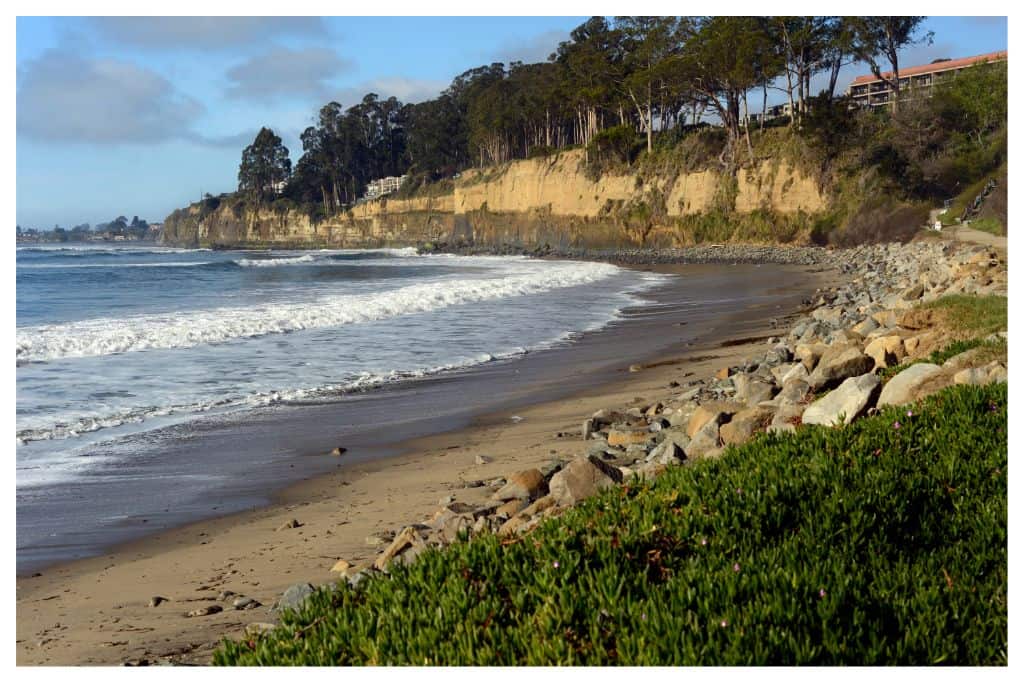
New Brighton State Beach lies on the shores of Monterey Bay just east of Santa Cruz. New Brighton State Beach is the beginning of a nearly 20-mile stretch of uninterrupted beach that reaches all the way to Moss Landing.
In warm months New Brighton is a great place to spend the day relaxing on the beach, building sand castles, and playing in the waves. The campground lays atop the beachside bluff and is just a short walk, roughly 5min, from the beach. My kids love playing on the beach here and my three-year-old can easily make the walk down the hill to the beach on his own (though depending on how hard he plays he sometimes needs some help back up!).
In addition to playing on the beach, the surrounding area is full of great opportunities to enjoy the outdoors, such as hiking, surfing, mountain biking, and more. A bay tour on a whale-watching boat, available out of Santa Cruz or nearby Moss Landing, provides a unique experience. Depending on the time of year it is possible to see Humpback Whales, Orca, and even Great White Sharks.
The campground is a well-maintained State Park campground. It has over 100 sites including 11 RV sites with electrical hookups. The best sites are the 9 premium sites along the bluff. They do carry an extra fee, but the view is well worth it if you can snag one.
Bathrooms have running water and coin-operated showers are available. The campground does have an RV dump station, but there is an extra fee not included with your camping fee.
New Brighton is an extremely popular campground and sites book up instantly, so be sure to plan well in advance and try to have some flexibility with your dates if you are wishing to visit.
23. Manresa State Beach
A little further to the south in Monterey Bay Manresa State Beach is a broad and sweeping expanse of beach. The beach is backed by small dunes that are great for kids to play in. If you are a surfer there are numerous great surf breaks nearby.
If you are looking to learn, Club Ed Surf (a long-running local surf school) offers summer surf camps based at Maresa State Beach for kids and adults.
The Manresa Uplands Campground is a tent-only campground that offers 64 walk-in sites. Sites are spread out between 10-200 yards from the gear drop-off point. After dropping off gear all cars must park in a central parking lot. Campsites include picnic tables and fire rings. Bathrooms include running water and coin-operated hot showers.
24. Sunset Beach State Park
Just another mile down the coast from Manresa is Sunset Beach State Park. As the name suggests you will be treated to fantastic views of Monterey Bay, especially at sunset. Both Manresa and Sunset are great alternatives to the more popular New Brighton State Beach to the north.
The broad expanses of beach at Sunset are far less crowded than the beaches closer to Santa Cruz and thus it is much easier to snag some space away from others.
The campground at Sunset Beach is tucked amongst the pines and grassy dunes behind the beach. There is a trail that leads down the hill to the beach, alternatively, visitors can drive down with their beach gear and park in the day-use lot on the beach side.
The campground offers a total of 90 sites. Trailers and RVs up to 30 feet are allowed, however, no hookups or dump stations are available. All sites include a picnic table and a fire ring. Bathrooms have running water and coin-operated hot showers.
25. Mt Madonna County Park
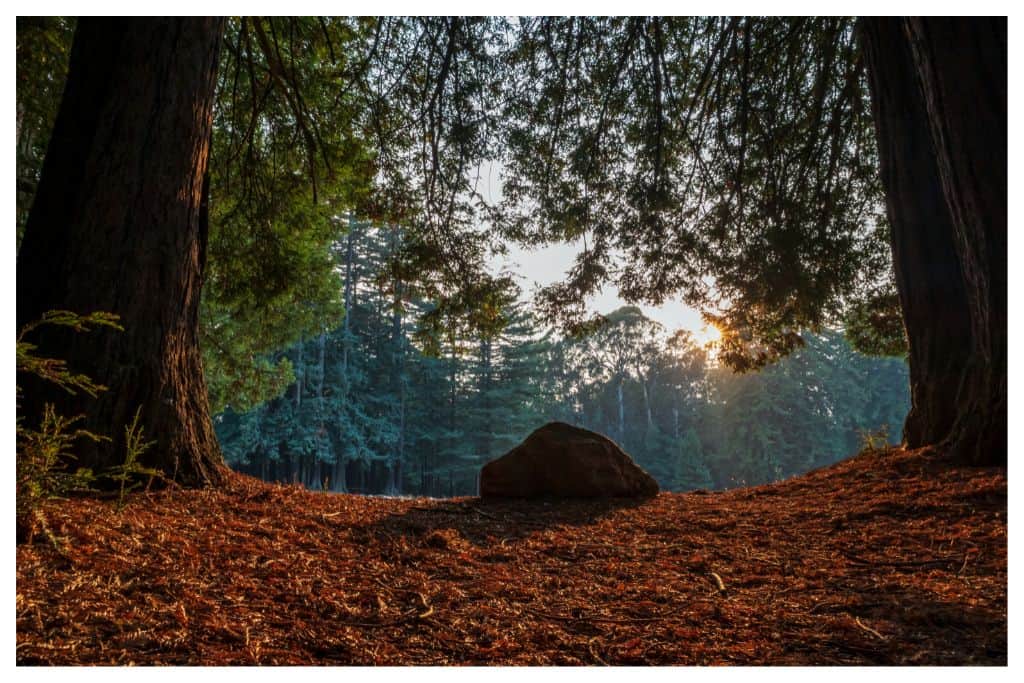
Just a few miles inland Mt Madonna County Park offers a wonderful opportunity to experience the Redwoods of the Santa Cruz mountains. Though the trees here are not nearly the size of those in the more well-known Henry Cowell or Big Basin, Mt Madonna nonetheless provides a great opportunity to experience a redwood ecosystem.
This 4,600-acre park offers 14 miles of hiking trails. Adjacent to the park is Mt Madonna Stables, which offers guided horseback rides along the park’s trails.
The campground at Mt Madonna has a total of 116 sites. There are 27 RV sites that have both water and electrical hook-ups, with a central dump station available. In addition to the tent and RV sites Mt Madonna also offers 5 Yurts that can accommodate between 6 to 10 people on bunk beds and fold-out futons.
Best Bay Area Car Camping:
Big Sur
I know, Big Sur is starting to get a little far to really be considered the “Bay Area”. However, given that Big Sur is one of the most beautiful stretches of coastline on the planet, I simply couldn’t write about camping in Central California without mentioning it.
Big Sur is where the mountains, quite literally, meet the sea. The Santa Lucia Mountains stretch 140 miles south along the coastline from Carmel. The range is never more than 11 miles wide and is the steepest coastal range in the lower 48 states. Cone Peak, drops from an elevation of 5,180 feet to the sea over a span of only 3 miles.
This magnificent area is full of amazing opportunities for camping and exploring the beaches, rivers, and mountains alike.
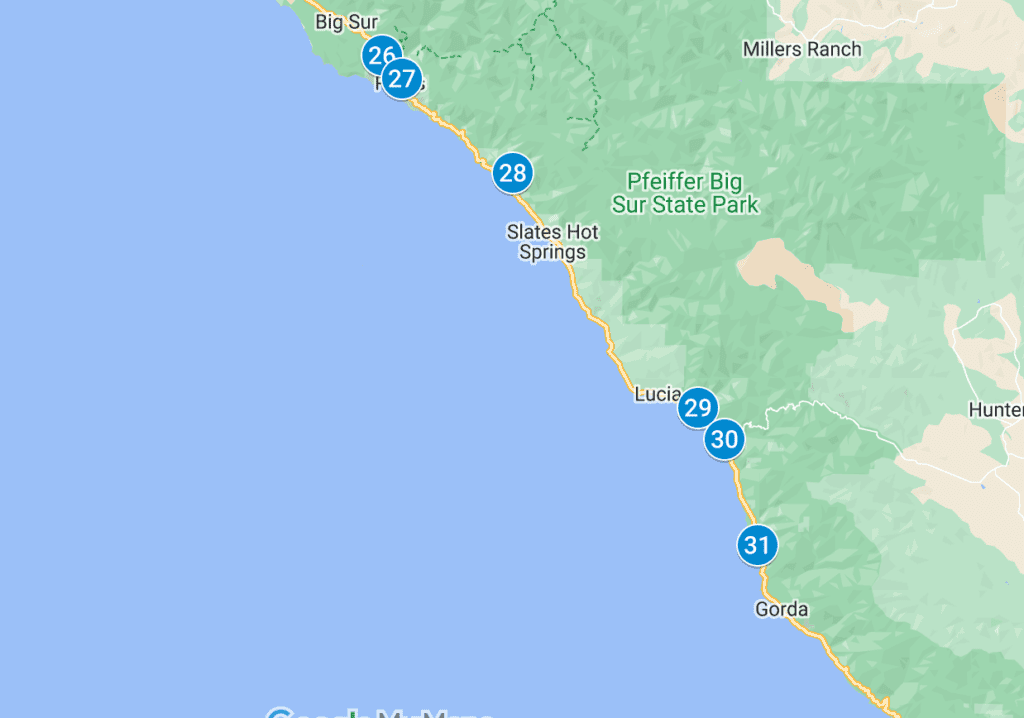
- Pfeiffer Big Sur State Park
- Ventana Campground
- Julia Pfeiffer Burns State Park
- Limekiln State Park
- Kirk Creek Campground
- Plaskett Creek Campground
26. Pfeiffer Big Sur State Park
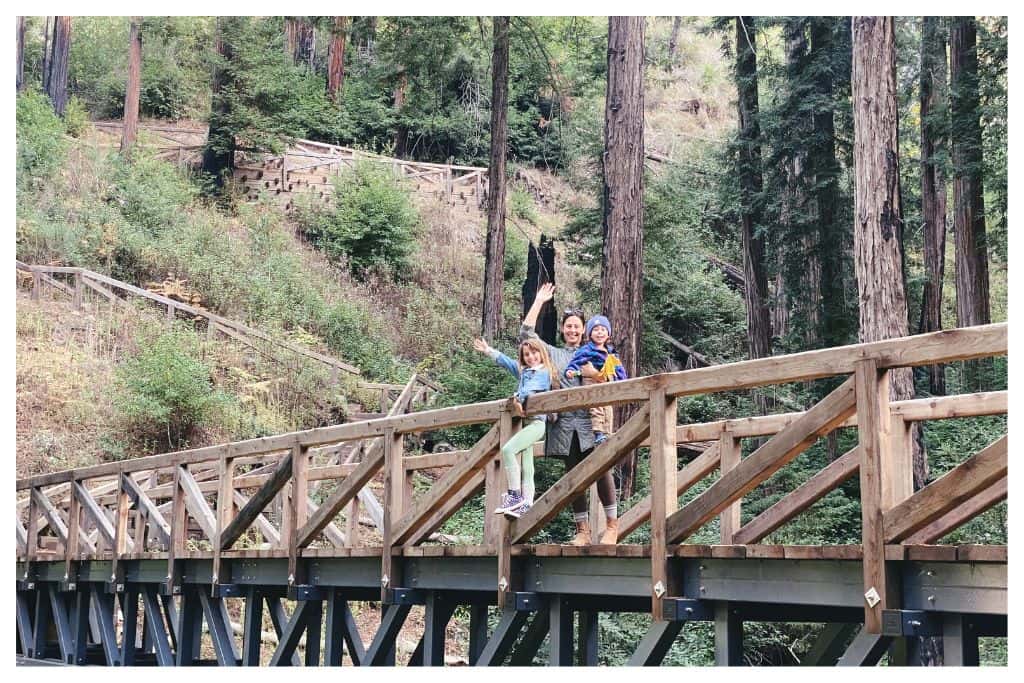
Located approximately 30 miles south of Carmel, along the banks of the Big Sur River, Pfieffer Big Sur State Park offers excellent hiking and swimming in the Big Sur River.
Visitors can hike through the redwoods, up to fantastic views of the coast, or up the Big Sur River Gorge in search of swimming holes. Families with young kids can spend time splashing in the slow-moving shallow sections of the river or hiking on one of many easy trails.
Whereas those in search of more adventure can ascend some of the more challenging trails in search of views of the coastline. No matter who you are there is plenty to keep you entertained.
The campground offers a total of 189 sites. Trailers of 27 feet and RVs of 32 feet can be accommodated but there are no hookups or dump stations available. All sites include picnic tables and fire rings. Bathrooms have running water with hot showers.
The campground sits along the Big Sur river and there are numerous great swimming holes all within walking distance. The premium riverfront sites come with an extra cost. This is an extremely popular campground and sites fill up six months in advance year-round.
27. Ventana Campground
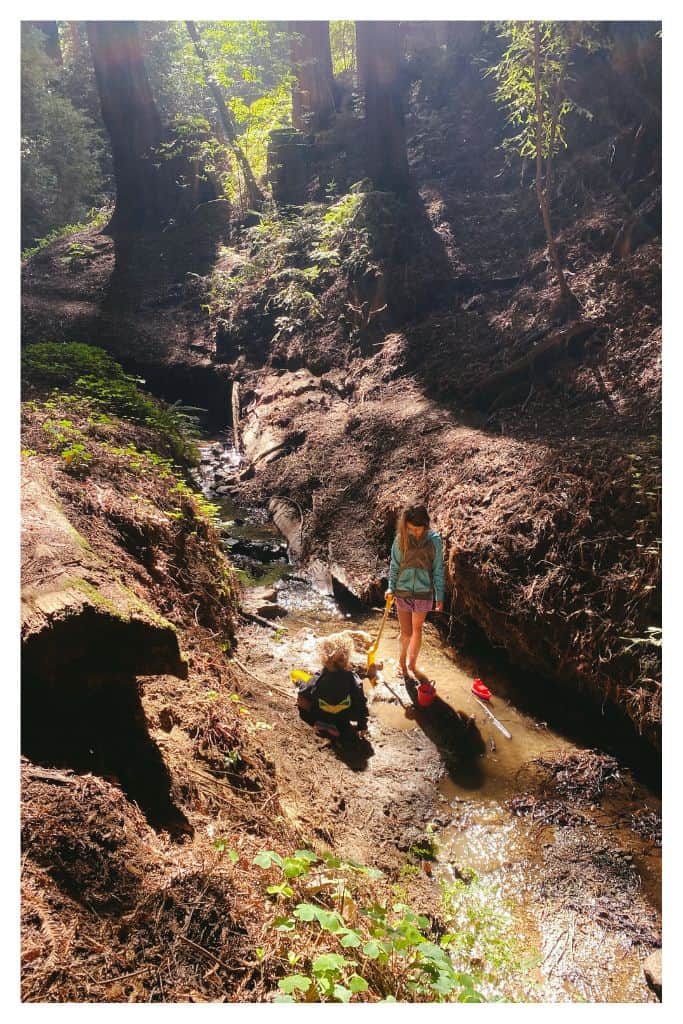
Just a few minutes down the road Ventana Campground is a private campground that offers tent-only sites tucked into the redwoods along Post Creek. It is a picturesque campground in a great location and is a great alternative if you are unable to find sites at Pfieffer Big Sur.
Sites here are relatively small and many are close together, don’t expect the same privacy you would experience in a State or National Park Campground. That being said, the sites are organized in small clusters, so even though you will likely have neighbors, it doesn’t have the ‘parking lot’ feel of some private campgrounds.
All sites include a picnic table and a fire ring. The bathrooms have running water and coin-operated showers are available.
We have stayed here a number of times, our kids love exploring the banks of the creek while we are in camp, and it is a very central location from which you make day trips to explore the rest of what Big Sur has to offer.
28. Julia Pfieffer Burns State Park
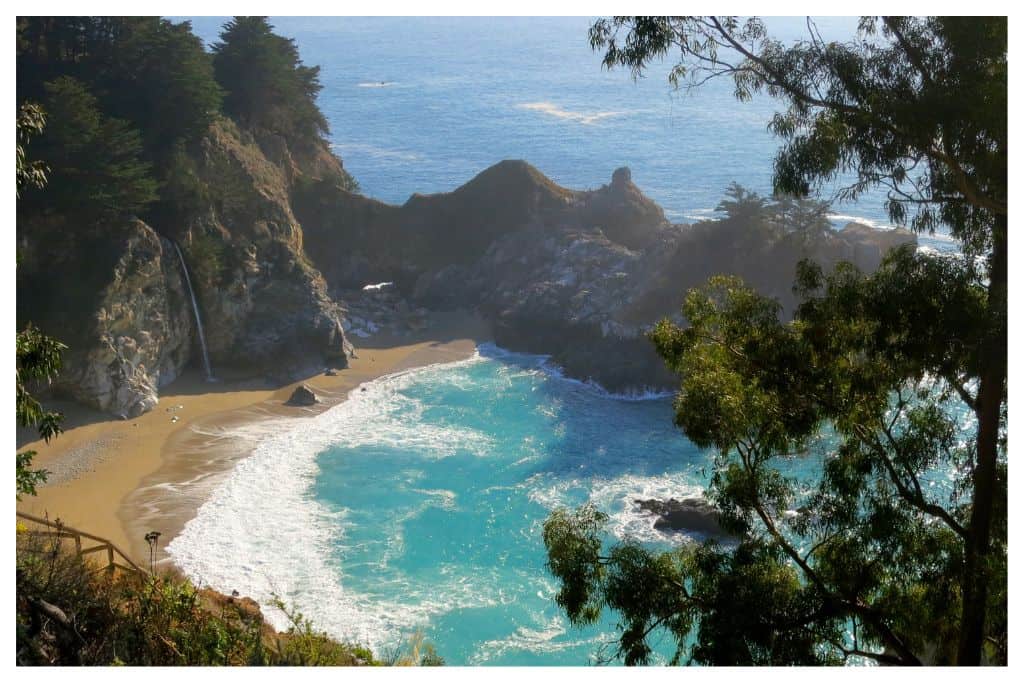
Julia Pfieffer Burns State Park offers just two very unique campsites. That’s right, with only 2 sites, this is certainly the smallest ‘campground’ on our list. However, these two sites are so amazing, I couldn’t leave them out.
The two environmental sites are located on the west side of Highway 1 and offer incredible views of the Pacific Ocean. They sit right on the edge of the nearly 100-foot cliffs overlooking the Big Sur Coastline.
These are hike-in-only sites, so you must carry all your water and gear about a half mile from the parking area. There is a pit toilet available at the campsites, or bathrooms with running water a short distance away in the park day use area.
These sites are so unique they are some of the most sought after in California and thus are extremely difficult to book.
Julia Pfieffer Burns State Park is home to the iconic McWay Falls. Views of the falls are accessible with just a short walk from the campground.
29. Limekiln State Park
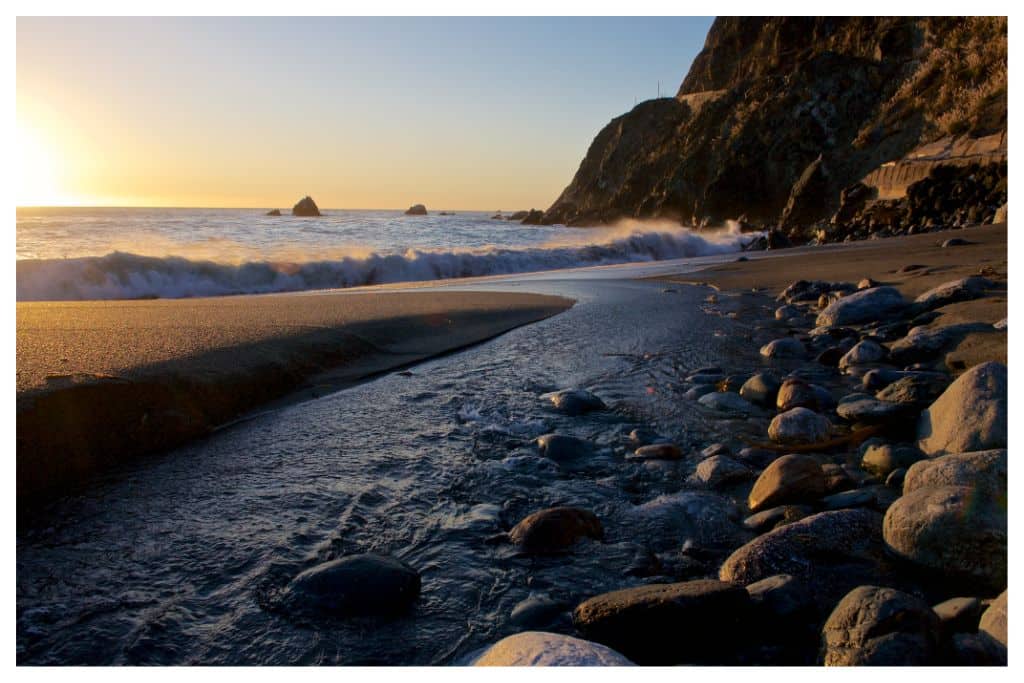
Moving further south Limekiln State Park offers both the redwoods and the beach all within walking distance. The park is roughly 50 miles south of Carmel. All from your campground you can hike among the redwoods, see a 100-foot waterfall, visit the historic limekilns from which the park gets its name, or play on a sandy beach.
The campground has both tent-only and RV-accessible sites. The RV sites can accommodate trailers up to 15 feet and RVs up to 24 feet. No hookups are available. All sites include picnic tables and fire rings. Bathrooms having running water and hot showers are available.
30. Kirk Creek Campground
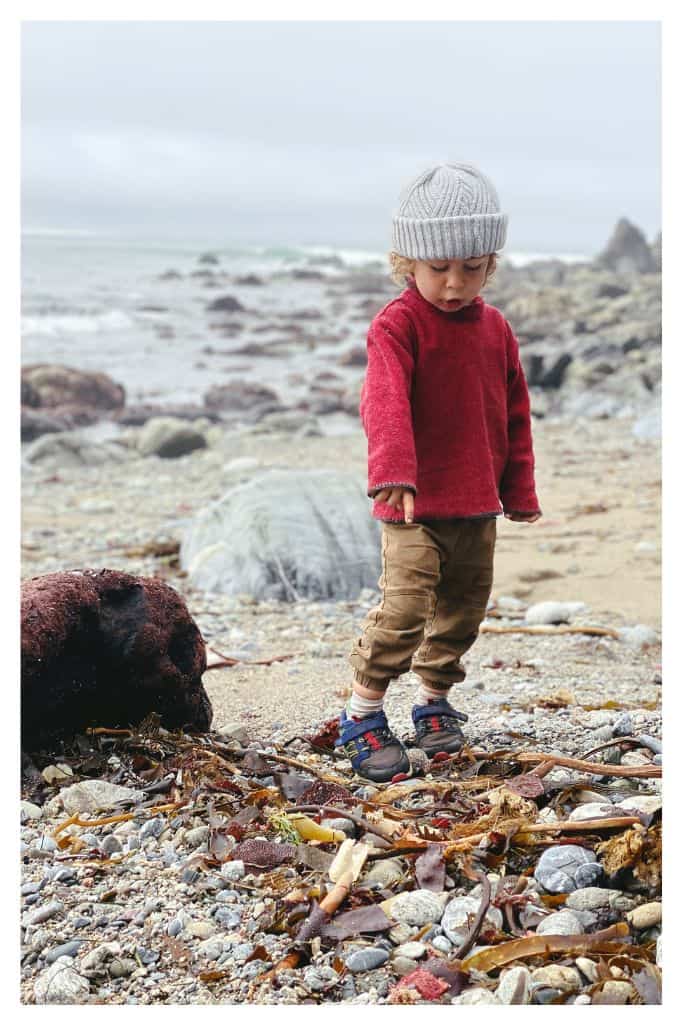
Kirk Creek Campground sits perched atop the bluff on the west side of highway 1. The oceanfront sites have, in many cases, an unobstructed 180-degree view of the Pacific Ocean and Big Sur coast. Just about every site in the campground has at least some view of the ocean.
There is a short trail that follows a creek down to the beach. The immediate section at the end of the trail is rocky but you can find sandy spots to relax in either direction. At low tide, there are great tide pools to explore that are brimming with sea life.
The campground has a total of 32 sites available to tents and RVs alike. There are also a few first-come first served walk/bike-in sites available at the bottom of the campground. While there is no designated parking for these sites it is possible to unload your gear and then park along the highway just outside the campground.
Note that Kirk Creek does not have water available. The closest place to fill up water is the fire station a few miles to the south. Bathrooms at Kirk Creek are pit toilets only.
31. Plaskett Creek Campground
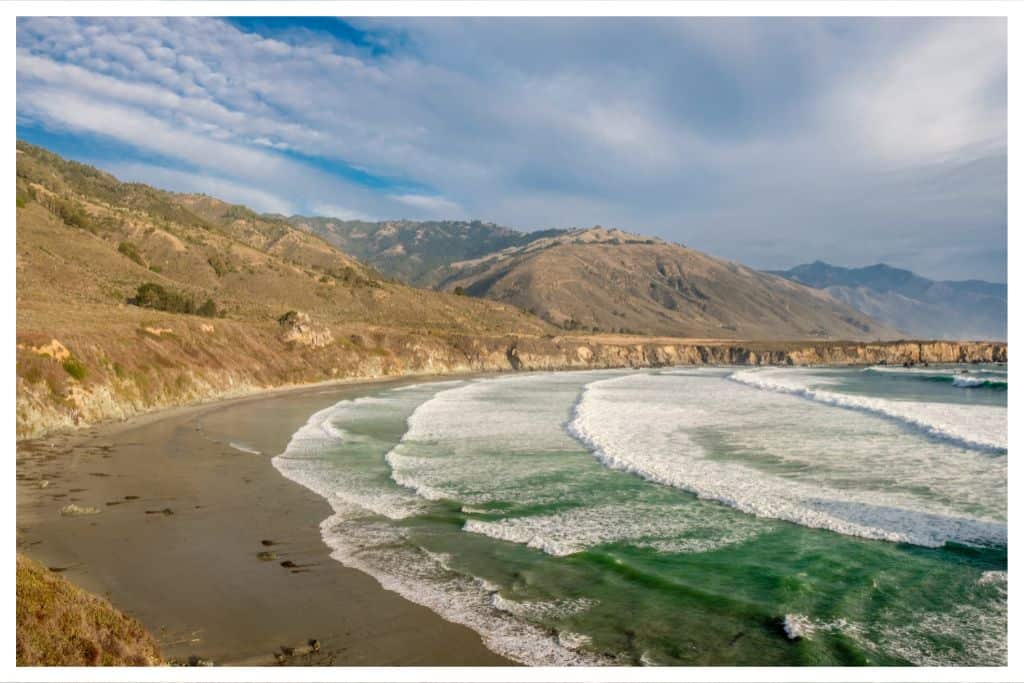
The final campground on our list is also the furthest south. Plaskett Creek is located roughly 60 miles south of Carmel on Highway 1. Plaskett Creek can, without question, no longer be considered the ‘Bay Area’. That being said, it is still less than a half days drive, and a beautiful one at that!
Plaskett Creek is located across the highway from Sand Dollar Beach, one of Big Sur’s premier beaches. Sand Dollar is a broad sandy stretch of beach that provides one of the few good surf spots in Big Sur. While the beach is not overrun with Sand Dollars as the name suggests, they can be found along the water line, especially at a low tide.
If you’re lucky you may even find some small pieces of jade stone buried in the sand. Jade was at one time much more prevalent and could easily be found laying on the beach. It has since been mostly picked over. Those more comfortable with the water may get lucky diving for jade.
The Plaskett Creek campground has a total of 44 sites. A few are available first-come-first-served, but the majority are booked out via recreation.gov. Sites are open to tents and RVs. There are no hookups or dump stations available. Bathrooms have running water, and there are water spigots throughout the campground.
The Best Bay Area Car Camping: Final Thoughts
I hope that this list of the best Bay Area car camping destinations has given you some inspiration for your next camping trip. I know that writing certainly has me fired up for our next trip!
As you can see there are many great opportunities to get outdoors right in or within a very short distance of the Bay Area.
Best of all, there is something available for just about all types of campers.
